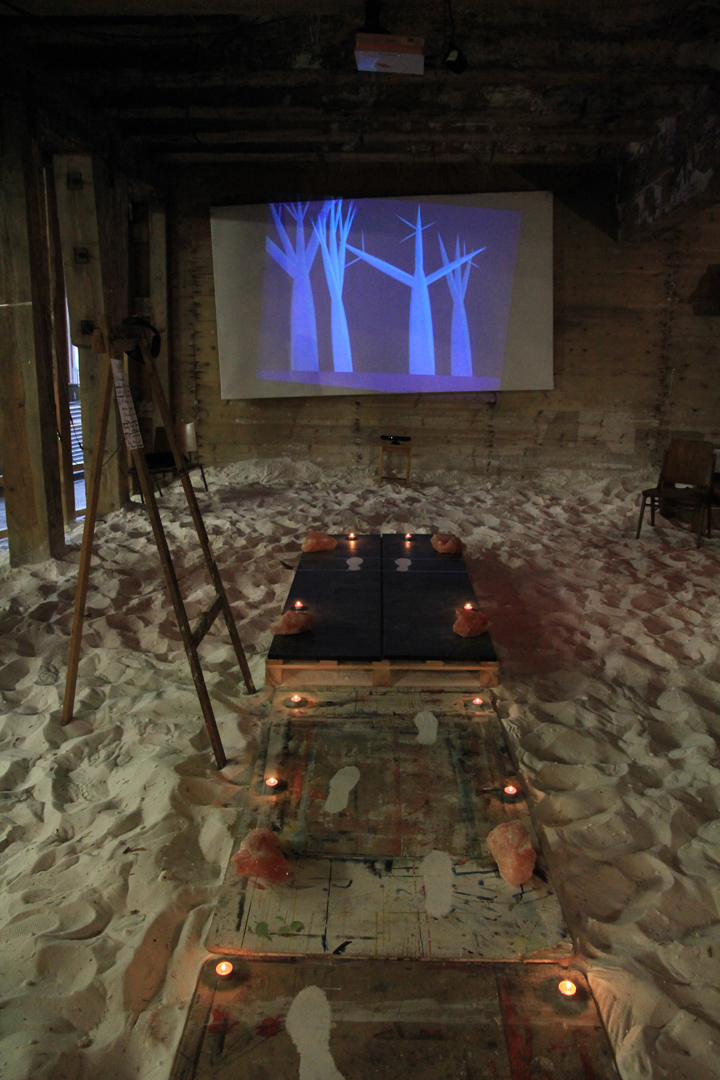An interactive installation which uses gamification techniques to encourage people to slow down and meditate.
Introduction
Magic Forest is an interactive installation featuring animated graphics and music that both dynamically respond to the movement of people who engage with the artwork. The project allows participants to discover their “inner tree” and a sense of calm and peace. Participants must move slowly and carefully in order to encourage an on-screen tree to grow – fast and careless movements destroy the forest. In the process, people are encouraged to reach into themselves and explore their own ideas of treelike nature.
By playing this video you agree to the terms of the Vimeo privacy policy. Your activity may be tracked by Vimeo through the use of cookies.
Development
Viktoria Miess had the idea for an animated forest at night, that would disappear if you moved too fast. I was drawn to the idea as I felt it would be an interesting way to explore the possibilities of interaction via a Kinect (motion tracking device), particularly as many works I have seen (including my own) encourage large and/or rapid movement, and the link between movement of the body and the on-screen reaction is sometimes unclear.
Ultimately we became a team of four people. I worked on a Processing sketch to take input from the Kinect and manage the game state. Paul Zubrinich created original music and the central tree animation. Viktoria and Jörg Barton created individual animations for flowers and leaves. We worked collectively to install the projector and other elements in the space. It was a rapid, prototyping style development process over eight days.
Presentation
The installation was presented at the Schmiede Werkschau. I was pleasantly surprised by how engaged many people were by the work. The audience spanned a wide range of ages, from children under 10 to adults in their (at least) 60s. Several people stayed in the space for over five minutes, past the length of the audio track, and seemed to really fall into a meditative state. The slow motion required to keep the trees alive encouraged gentle, exploratory movements. The ambiguity of the relationship between body movement and the tree on the screen seemed to invite people to express their unique idea of tree-like movement, from fluttering finger-leaves to gentle swaying to stiff, strong stances. Many people moved in (what were to me) unexpectedly beautiful, fluid, and expressive ways, often in front of a group of random spectators waiting their turn.
I was really happy with how this installation worked and it was a big realisation for me that a more technically simple implementation (tracking only three points of the 27-point skeleton) can be more powerful in an artistic sense if it allows for more freedom of expression from the participants. I would like to explore the idea of gamification of calm again in the future.
Technology
The installation was managed by a Processing sketch with a Kinect used to register body movements. The two wrist positions and the chest position from the Kinect skeleton were used to control the sway of the tree, which was rendered using Processing. Rapid movement resulted in the forest turning to sand. The sound was also game-state specific and managed by Processing. We used a set of headphones as a practical measure because it was a noisy area, but in the end they had the beneficial effect of encouraging inward reflection by enveloping the participant in their own private auditory space.
Installation
September 2016
Schmiede Werkschau
Hallein, Austria
Role
Interaction design
Software development
Collaborators
Viktoria Miess
Paul Zubrinich
Jörg Barton
Tools and Technology
Processing
Kinect







